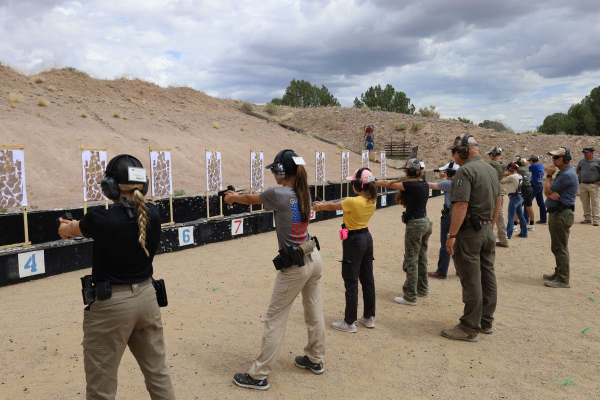Today’s feature comes to us from Greg Moats.
Twenty-five years ago, I noticed that my children occasionally spoke a pidgin-version of my lingo, but we could still understand each other. Currently, by way of contrast, my grandchildren often speak in tongues that even the most talented Berlitz Instructor couldn’t make me understand. Ultimately definitions are determined by their usage. Take for instance the term, “influencer.” To people in my grandchildren’s generation an “influencer” is a technical term for some sort of social media maven. To me, a baby-boomer now into his eighth decade, “influencers” were people like Colonel Jeff Cooper. His “influence” on my life was doctrinal and indelible, not superficial, and momentary. Aside from my love of God and Country, my love of guns and shooting is probably the least ephemeral facet of my life and it was largely “influenced” by Cooper.

I desire that my grandchildren learn and experience something of value relating to guns and shooting, and that’s something that they won’t stumble across while “cyber-surfing” on their cell phones. Cooper’s influence thru the vehicle of his legacy, Gunsite Academy, is still available and has been providing value since 1976.
Ten years ago, some of the Gunsite staff requested that a special version of the 250 class be conducted for their teenage family members and close friends. The 250 class is the original program conducted by Colonel Cooper and is required for all students, regardless of experience, to complete prior to taking more advanced classes. Gunsite’s owner, Buzz Mills, okayed the project and the first “Youth 250” class was conducted with 5 students. All involved in the experiment felt that it was successful enough to repeat it the following year. The next scheduled class was offered publicly to individuals aged 12-16 and the roster doubled to 10 students. Realizing that they had a marketable product on their hands, they set about developing a curriculum that would contain all the material covered in the standard 250 class but delivered in a manner that would be effective for teenagers.
According to Gunsite’s Director of Training, Dave Hartman, the school exercises, night-shoot, house-clearing, ravine-walk and man-against-man drills that the Youth-class perform are identical to those conducted in the adult class. Delivery of the material varies slightly, but the content is identical. Teenagers have different life experiences, attention spans and fewer bad habits to unlearn than adult students, so the pace of the Youth-class is different. While breaks are scheduled in advance for the adult classes, the instructors of the Youth-class have the flexibility to break whenever they feel the attentiveness of the students is lagging. Prior to starting the Youth-class on Monday morning, Gunsite schedules a Sunday afternoon barbecue to allow the class members and their parents to have an overview of coming events. At the conclusion of the meeting, students are paired off with a “battle buddy.” They are to remain inseparable throughout the week ensuring that their partner is drinking plenty of water, keeping their magazines loaded, is promptly getting on the firing line when their relay is called and acting as a general cheerleader for their buddy’s accomplishments. They interview them at the end of the barbecue and then introduce them to the class first thing Monday morning. They also begin each morning and afternoon session by having two students tell the class a joke. As a result, the Gunsite staff have found that camaraderie is built much quicker in the Youth-class than in the standard class format.

Evolution of Doctrine
The guiding ideology that drove the initial development of Gunsite’s curriculum was a concept that Cooper labeled, “The modern technique of the pistol.” He defined the components of the modern technique as: The Fighting Stance, Presentation, Flash Sight Picture, Compressed Surprise Break and Heavy Duty Pistol. To the Colonel, who was never afraid of dogmatism, “Fighting Stance” meant (and was originally titled) “The Weaver Stance.” A hallmark of professionalism is the ability to adapt and evolve methodology and Gunsite no longer presents the Weaver Stance as THE “correct” way to shoot, therefore the title “The Weaver Stance” was changed to “The Fighting Stance.” Gunsite has students experiment by shooting with their support-side foot slightly forward (like Weaver), then try shooting with their feet even (as with Isosceles) and even had them attempt to shoot with their strong-side foot forward (like Jerry Miculek). The Youth-class shooters are told to adopt the method that felt most comfortable as long as it was a balanced fighting stance. The guidebook that every student receives has added a detailed description of the “Modified Isosceles” stance; proteges of the modern technique no longer worship solely at the altar of the Weaver Stance.

Likewise, when teaching strong-hand-only shooting, students practice with the handgun canted inboard and perpendicular with a combination of their strong-side foot forward, both feet even and support-side foot forward. Students then were told to select which combination was the most comfortable for them.
The strong-hand shooting session was the ideal segue into shooting with the use of an auxiliary flashlight. Two techniques were presented to the Youth class, the FBI technique and the Harries method. The FBI technique has the shooter hold the flashlight with the arm extended away from the shoulder. This gets the light away from the shooter’s head and body in case their adversary shoots at the light. The Harries method, named for early Gunsite Instructor Michael Harries, has the shooter firmly press the back of their support hand against the back of the strong hand and form isometric tension to stabilize the handgun. Due to the influence of Gunsite, if you see an actor using a flashlight on TV or in the movies, the chances are they’re employing the Harries method.
More to follow ...
— Greg Moats